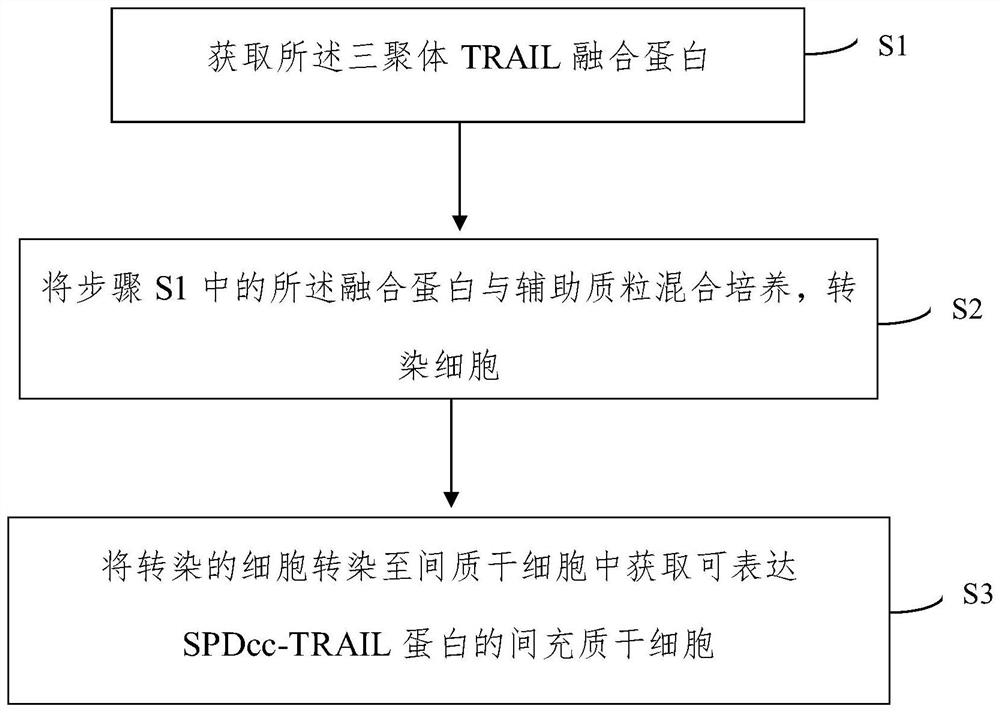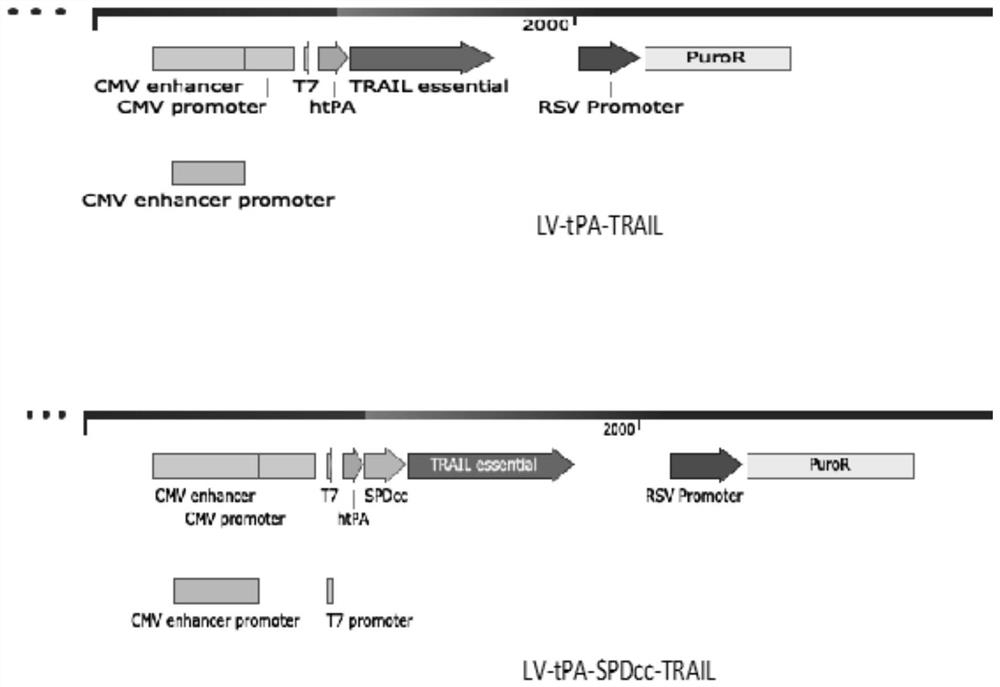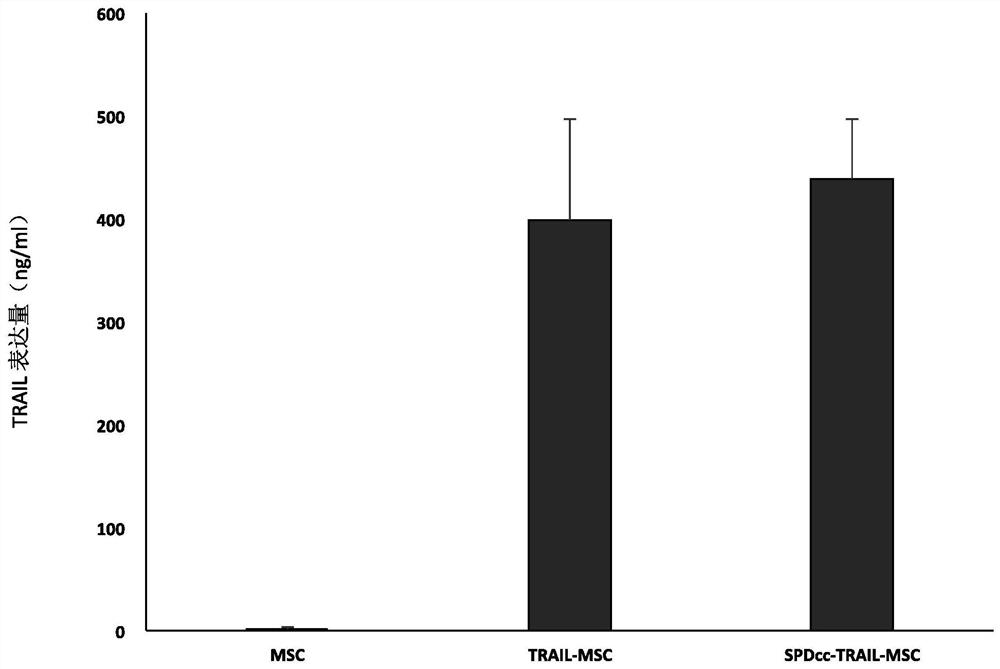Method for genetically modifying mesenchymal stem cells with trimer trail fusion protein and use thereof
A technology of mesenchymal stem cells and fusion protein, applied in the field of modification of mesenchymal stem cells, can solve the problem of poor stability of trimeric TRAIL protein
- Summary
- Abstract
- Description
- Claims
- Application Information
AI Technical Summary
Problems solved by technology
Method used
Image
Examples
Embodiment 1
[0048] A trimeric TRAIL fusion protein, its nucleic acid sequence is as SEQ ID NO:1. The fusion protein includes:
[0049] Secretion signal protein, selected from tPA, IL-2 and SEC, preferably tPA, its nucleic acid sequence is as SEQID NO:2;
[0050] Pulmonary surfactant protein (pulmonary surfactant protein-D, SPD), its coding region is the amino acid amino group of 224-255, and its nucleic acid sequence is shown in SEQID NO:3;
[0051] Humanized tumor necrosis factor-related apoptosis-inducing ligand (homo sapiens tumor necrosis factor-related apoptosis inducing ligand, hTRAIL), its coding region is 114-281 amino acid residues, and its nucleic acid sequence is shown in SEQ ID NO:4.
[0052] The preparation method of trimeric TRAIL fusion protein, comprises the steps:
[0053] (1) Design and synthesize tPA, SPDcc, TRAIL and other gene sequences respectively.
[0054] (2) The sequences of tPA, SPDcc, TRAIL and the like were sequentially linked into tPA-SPDcc-TRAIL by using ...
Embodiment 2
[0059] A method for modifying mesenchymal stem cells with a trimeric TRAIA fusion protein, comprising the steps of:
[0060] S1, obtaining the trimeric TRAIL fusion protein;
[0061] Wherein, the preparation method of the trimeric TRAIL fusion protein is the same as that in Example 1.
[0062] S2. The fusion protein and the helper plasmid are mixed and cultured, and the cells are transfected;
[0063] Among them, the transfection methods include virus transfection, liposome transfection, electrotransfer transfection, gene editing transfection and mRNA transfection.
[0064] Trimeric TRAIL fusion protein and auxiliary plasmid mixed culture includes the following steps:
[0065] (1) Mix the fusion protein plasmid and helper plasmids pMDLg, pRSV / REV, and pMDNA2.G, dissolve the mixed plasmids in Opti-MEM medium, and let stand for 5 minutes;
[0066] (2) Add PLUS again TM Reagent, let stand for 5min;
[0067] (3) Will Mix the LTX reagent with the Opti-MEM solution, let it st...
Embodiment 3
[0079] Example 3. Stability detection of TRAIL protein secreted by gene-modified mesenchymal stem cells The two kinds of gene-modified mesenchymal stem cell culture supernatants obtained in Example 2 were used and placed in a warm bath at 37°C at different times (0 , 24h, 48h, 72h and 96h) aspirate a small amount of supernatant, and quickly store it in a -70°C refrigerator. After sampling at all time points, the TRAIL protein content of each sample was determined by the method described in Example 3.
[0080] Taking the protein content of each treatment group as %, calculate the TRAIL protein residual rate of each treatment group at each time point according to the following formula:
[0081] Residual rate = (TRAIL concentration at each time point / OhTRAIL concentration) x 100%
[0082] As a result, it was found that compared with the control group (TRAIL gene modified MSC), the TRAIL expressed by the SPDcc-TRAIL gene modified MSC constructed by the method of the present inven...
PUM
| Property | Measurement | Unit |
|---|---|---|
| molecular weight | aaaaa | aaaaa |
| molecular weight | aaaaa | aaaaa |
Abstract
Description
Claims
Application Information
 Login to View More
Login to View More - R&D Engineer
- R&D Manager
- IP Professional
- Industry Leading Data Capabilities
- Powerful AI technology
- Patent DNA Extraction
Browse by: Latest US Patents, China's latest patents, Technical Efficacy Thesaurus, Application Domain, Technology Topic, Popular Technical Reports.
© 2024 PatSnap. All rights reserved.Legal|Privacy policy|Modern Slavery Act Transparency Statement|Sitemap|About US| Contact US: help@patsnap.com










